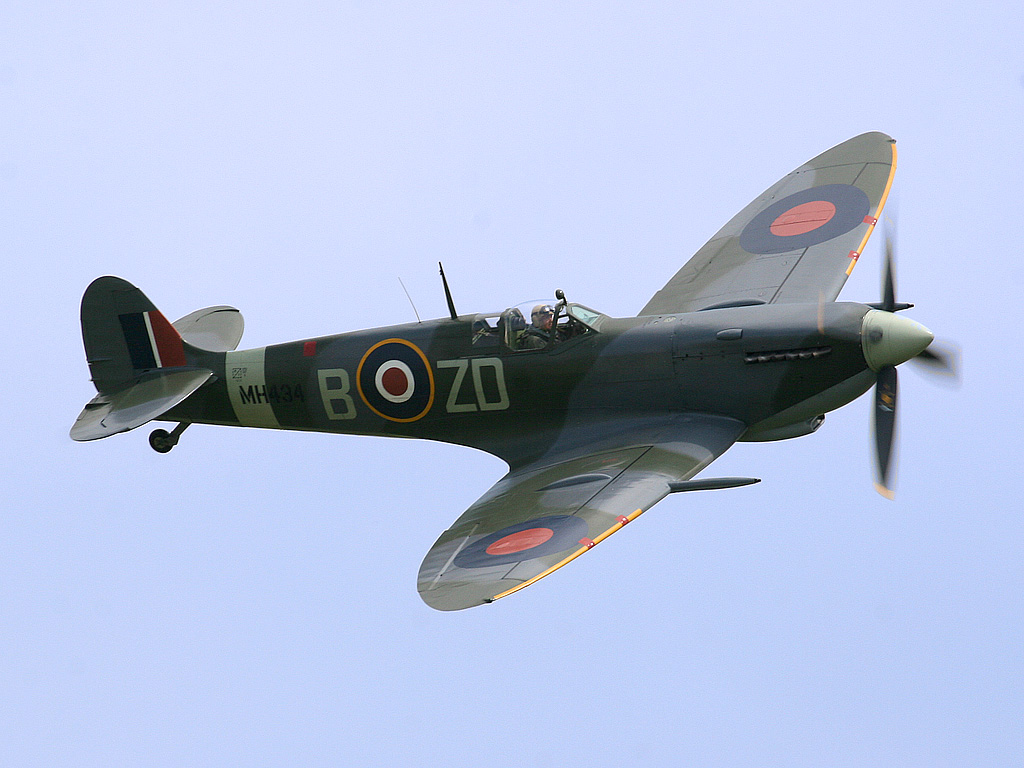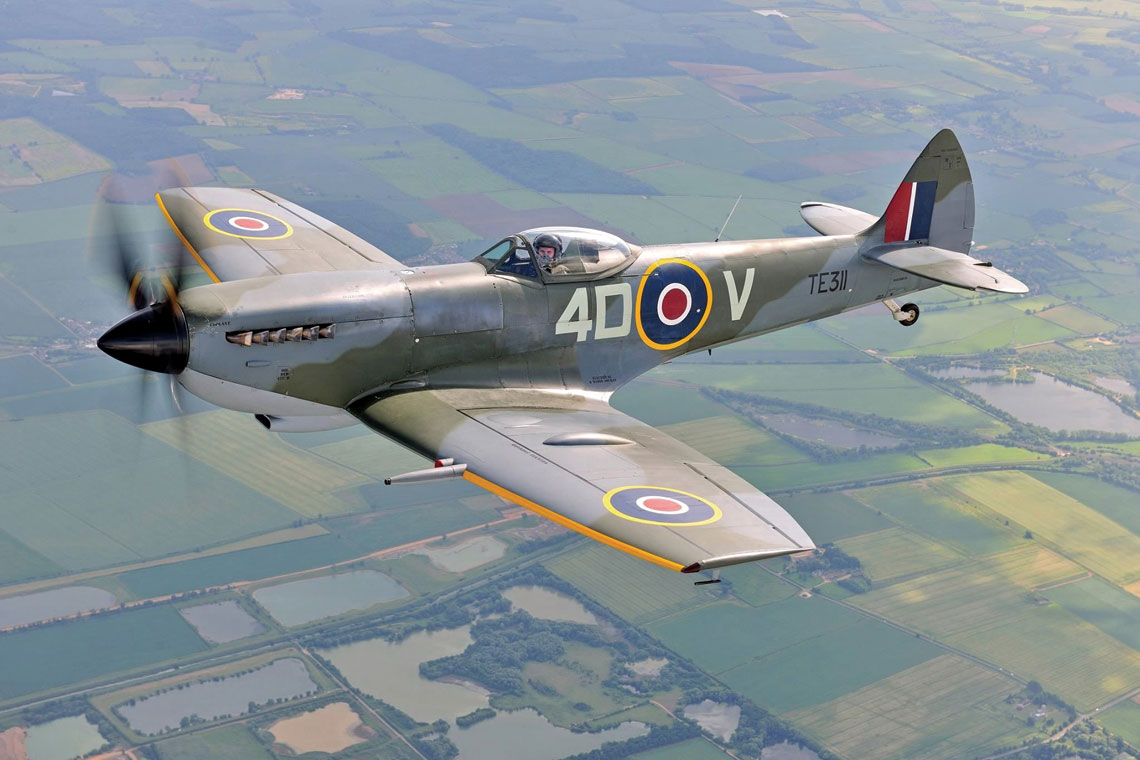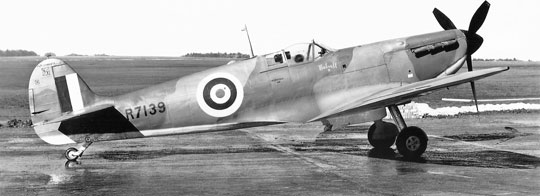
The legendary fighter of the RAF Supermarine Spitfire, part 2

The currently preserved copy of the Spitfire XVIIE in flight. The aircraft belongs to the Battle of Britain Memorial Flight and bears the designation of No. 74 Squadron RAF.
When the prototype, designated K5, was flown on March 1936, 5054, when the Spitfire name was not yet known, and when designer Reginald Mitchell began to slowly kill colon cancer, it was already known that an aircraft with great potential would appear. However, what happened next, that this aircraft flew throughout the Second World War, without losing much of its value, was not expected by anyone.
The prototype did not make its second flight immediately. The fixed-pitch propeller was replaced with an optimized one for high speeds, landing gear covers were installed, and the landing gear itself was unlocked. The aircraft was put on lifts and the wheel cleaning mechanism was tested. The prototype and the first Spitfire I of the 174 series had a hydraulically retractable undercarriage with a manual pressure pump to fold and extend the undercarriage. Starting with 175 units, it was replaced by an engine-driven pump with a maximum pressure of 68 atm (1000 psi). There was also an emergency release of the landing gear from a carbon dioxide cylinder located in the cockpit on the starboard side. A special lever marked "emergency only" caused a single puncture of the valve of a specially sealed cylinder and the release of the landing gear with compressed carbon dioxide, without the possibility of retracting the landing gear after an emergency release.
Initially, the designers introduced only light signals for the release and blocking of the landing gear, but at the request of the pilots, a mechanical signaling appeared, the so-called. soldiers on the wings (small sticks protruding above the surface of the wing). On all Spitfires, the hydraulic system was used only for retracting and extending the landing gear. Flaps, wheel brakes, reloading of small arms, and on later modifications, the compressor was also switched to higher gear by a pneumatic system. A compressor was fitted to the engine, which generated 21 atm (300 psi) of compressed air. With a special valve, this was reduced to 15 atm (220 psi) for the flaps, armament and compressor, and to 6 atm (90 psi) for the wheel brakes. The turning of the aircraft on the ground was carried out by a differential braking action, i.e. pressing the steering pedal all the way to the left and pressing the brake brakes only the left wheel.
Returning to the chassis, the K5054 used a rear sled, which was replaced with a wheel on the standard Spitfire I. On the other hand, the crocodile flaps on the prototype deflected 57° just for landing. Start on the Spitfire (all modifications) was made without flaps. Since the aircraft had an exceptionally clean aerodynamic line and a fairly high perfection (ratio of lift to drag coefficient), the K5054 approached landing with a relatively shallow angle, as the aircraft accelerated on a steeper descent. Once leveled out, it tended to "float" with little loss of speed, even when the engine was idling. Therefore, on production aircraft, it was recommended to increase the deflection of the flaps to 87 °, while they performed a greater braking function. Landing properties have definitely improved.

The first version, the Spitfire IA, was armed with eight 7,7 mm Browning machine guns with an ammunition capacity of 300 rounds per km and was powered by a 1030 hp Merlin II or III engine.
After checking the retracting mechanism and retracting the landing gear, the aircraft was again ready to fly. On March 10 and 11, the second and third flights were made on it with the landing gear retracted. At that time, Eastleigh Corporate Airport near Southampton was visited by Air Marshal Hugh Dowding, who at the time was a member of the Air Ministry's Air Board as "Air Supply and Research Member", only on 1 July 1936 did he take charge of the newly formed RAF Fighter Command . He was very pleased with the aircraft, recognizing its high potential, although he criticized the poor view from the cockpit down. In K5054, the pilot sat lower, under the fairing, inscribed in the outline of the hump behind the cockpit, the fairing did not yet have the “pale” characteristic of the Spitfire.
Soon, starting on March 24, further flights on K5054 were performed by C. Resident (Lieutenant) George Pickering, known for making loops on the Walrus flying boat, sometimes launching it, to Mitchell's dismay, from a height of 100 m. He was excellent pilot, and the prototype of the new fighter was not difficult for him. On April 2, 1936, K5054 was certified for test flights, so each flight was no longer experimental. This allowed other pilots to fly it.
During the tests, problems were revealed with a near-prototype engine that did not want to start, so after several flights it was replaced with another one. The original Merlin C actually produced 990 hp. After replacing the engine, testing of the prototype, especially in terms of flight performance, continued with a double intensity. During testing, no major defects were found, except that the rudder was overcompensated and moved with excessive ease at all speeds. The speed of the prototype was about 550 km / h, although more was expected, but Mitchell believed that the speed would increase with the planned improvements. In early April, K5054 was taken to Farborough for wing resonance testing. It turned out that the flutter also occurred a little earlier than expected, so the prototype dive speed was limited to 610 km / h.
The K9 returned to Eastleigh on 5054 April and was taken to the maintenance hangar the following day for modifications recommended after initial testing. First of all, the horn balance of the rudder has been reduced, the shape of the end of the vertical stabilizer has been slightly changed, the air intake area to the carburetor has been increased, and the engine casing has been strengthened. . At first, the aircraft was painted light blue. Thanks to the employment of painters from Derby, from Rolls-Royce (cars), an exceptionally high surface smoothness was achieved.
On May 11, 1936, after modifications, the aircraft was again taken to the air by Geoffrey K. Quill. It turned out that the plane, after better balancing of the steering wheel, is now more pleasant to fly. The force on the pedals was now slightly greater than on the handle, helping to maintain proper coordination. The control lever became stiffer both in the transverse (ailerons) and longitudinal (elevator) directions at high speeds, which was normal.
During tests on May 14 at a speed of 615 km / h in a dive, as a result of vibrations from under the left wing, the landing gear came off, which hit the rear of the fuselage. However, the damage was minor and was quickly repaired. In the meantime, the RAF began pressing for the prototype to be sent for testing as soon as possible at Martlesham Heath, then the site of the Aircraft and Armament Experimental Establishment (A&AEE; near Ipswich, about 120 km northeast of London). who on September 9, 1939 was transferred to Boscombe Down.
Even after painting and fixing, the K5054 reached a top speed of 540 km/h in level flight. It turned out, however, that the propeller was to blame, the tips of which exceeded the speed of sound, losing efficiency. However, at that time, new ones were designed, with an improved profile and a slightly smaller diameter, thanks to which, on May 15, a horizontal flight speed of 560 km / h was achieved. This was a definite improvement and clearly over 530 km/h achieved by the competing Hawker Hurricane, which was technically much easier to mass produce. However, Mitchell now decided that the aircraft could be transferred to the A&AEE at Martlesham Heath for testing. On May 15, the aircraft reached an altitude of 9150 m, after which it was returned to the hangar to prepare for transfer.
Since there were not enough Browning machine guns, instead they had ballast in the wings of the aircraft imitating them, but this made it impossible to test weapons. But the Ministry of Aviation on May 22 agreed to the delivery of a prototype in this form. Finally, on May 26, Joseph "Mutt" Summers delivered K5054 to Martlesham Heath.
RAF testing
It was common practice when a factory pilot delivered a new aircraft to A&AEE, it was first weighed and checked while the RAF pilot prepared to fly, studying its performance. Typically, the first flight took place about 10 days after delivery. However, in the case of K5054, the Ministry of Aviation received an order to immediately take it into the air. That is why, after arrival, the plane was refueled, and "Mutt" Summers showed the captain. J. Humphrey Edwards-Jones found the position of various switches in the cabin and gave him instructions.
The first flight of the new aircraft was made on 26 May 1936, the same day the prototype was delivered to Martlesham Heath. He was the first RAF pilot to fly a prototype fighter. When he landed, he was ordered to call the Air Ministry immediately. Major General (Air Vice-Marshal) Sir Wilfrid Freeman asked: I don't want to ask you everything, and of course you don't know everything yet. But I want to ask, what do you think, is a young pilot capable of operating such a technologically advanced machine? This was the main concern of the Royal Air Force - is the plane too advanced? Edwards-Jones answered in the affirmative. Provided the pilot is properly instructed in the use of retractable landing gear and flaps. Well, it was something new, the pilots had to get used to extending the landing gear before landing, as well as the flaps to ease the approach at a lower speed.
The official report confirmed these observations. It says that K5054 is: simple and easy to pilot, has no serious flaws. The rudders are perfectly balanced to provide the perfect compromise between maneuverability and shooting platform stability. Takeoff and landing are correct and easy. The first flights of the K5054 in A&AEE decided the fate of the aircraft - on June 3, 1936, the Air Ministry ordered a series of 310 fighters of this type from Vickers Supermarine, the largest order for one type of aircraft placed in the 30s at the British aircraft factory. However, three days later, on June 6, 1936, this record was brutally broken - 600 Hurricane fighters were ordered from the Hawker plant. By ordering two types of aircraft with the same purpose, the Royal Air Force avoided the risk of failure of one of them. The Spitfire had slightly better performance, but was also more difficult to manufacture, so the less labor-intensive Hurricane could be delivered to larger units at the same time, speeding up the generational change.
On June 4 and 6, the speed of K5054 was measured, reaching 562 km / h at an altitude of 5100 m. At the same time, however, several minor defects were noticed during the tests, which should be eliminated in order to get a full-fledged fighter. First of all, attention was paid to the cockpit cover, the visibility of which was to be improved for better tracking of the enemy during air combat, the current visibility was sufficient for "normal" piloting of the aircraft. It was also noticed that the elevator at low speeds works too efficiently, which during one of the landings almost led to disaster - one of the test pilots hit the grassy surface of the airport with the tail skidding with the nose at an angle of 45 ° upwards. . It was proposed to limit the range of rudder deflection, and at the same time keep the range of stick travel so that stick movement translates into less rudder movement. Another thing is the heavy movement of the radiator shutter at high speeds, the “stiffness” of the steering wheel during a high-speed dive, difficult access to the radio technical service, etc.
Testing at Martlesham Heath continued until June 16, 1936, when Geoffrey Quill arrived to take K5054 back to Eastleigh, to the factory. During landing, it turned out that the plane used up quite a lot of oil. It was obvious that there was a leak somewhere. And two days later, on June 18, 1936, a small show for the press and the public was scheduled at the Vickers Supermarine. The company wanted to advertise its latest products, including the Wellesley bomber prototypes and the recently launched Wellington prototype, the Walrus amphibious prototype, the Straner and Scapa flying boats already in production. Did this company miss the Type 300, the future Spitfire? Geoffrey Quill thought that since the Type 300 has a 32 liter oil tank and the flight should only last about 5 minutes, why not? Too much won't leak… Rolls-Royce spokesman Willoughby "Bill" Lappin spoke out against this. Turns out he was right...
No sooner had Geoffrey Quill pulled away on the K5054 than the oil pressure dropped to zero. The engine could stall at any moment. The pilot made a circle at the minimum speed necessary to keep in the air, and landed safely. Luckily, nothing happened, although it was close. After checking the engine, it turned out that it was not badly damaged, but it needed to be replaced. After being replaced, K5054 took to the air again on June 23, 1936.

